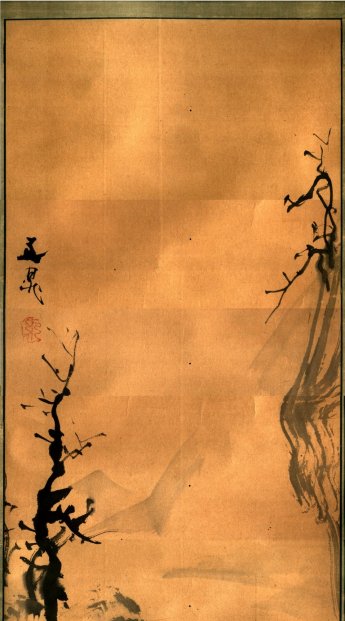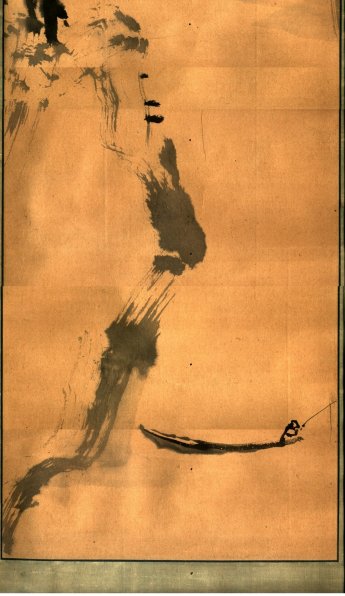





Japanese Zen Landcape Painting by 19C Master Artist Buncho Tani 文晁 (A.D. 1764-1840)
Scroll Size 57" X 14". PAINTING SIZE 41" X 11"
Buncho文晁(A.D. 1764-1840) N. Tani Buncho 谷文朝 and later Buncho文晁 F.N. Bungoro文五郎 Go. Shazanro寫山樓, Gagakusai 畫學齋, Shoso蜨叟, Muni無二, Ichijo一恕, BUn-ami 文阿彌 S. Nanga school. Pupil of Bunrei and Kangan. created his own style, studying old painting of both Japan and China. L&C. Born in Edo. Served Lord Tayasu and became a painter. Called the greatest painter in Edo at that time. But, now, his works are not so valued as in his time, because he is too prolific. Wrote "Honcho Gasan" 本朝畫纂 etc. Sp. landscape, figures, flowers and birds.
Tani Buncho (1763-1840), a well-known painter of the late Edo Period, was an artist of considerable talent. He worked in a variety of painting styles, including those of the Kano and Tosa schools, as well as the nanga (literally, the Southern style of Chinese painting) style. Buncho's fame was due to his fine artistic skills. In his heyday, he obtained a high position as a favorite painter to the samurai class of the Tokugawa Shogunate. In the early Edo Period, Kano Tan'yu (1602-1674) had risen to a similar position of recognition. Among Tan'yu's works are numerous small-sized sketches, or reduced copies (shukuzu), of Japanese and Chinese masterpieces. Like his predecessor, Buncho also produced many reduced copies of famous paintings and firmly believed in the importance of such activity, as is evident from his remarks in a letter to his disciple Funatsu Bun'en.
Buncho is known as one of the most prolific and innovative painters of Japan. Although fundamentally a painter of the Bunjin school, he is most known for his innovative works which show influences of western modes of painting. For example in the current work, the use of the colors blue and green date back to early Chinese landscape paintings. However, the inclusion of a distinct horizon at the upper right is extremely unusual for Japanese or Chinese landscape paintings. Perhaps Buncho saw Dutch copperplate etchings that were imported to Japan at the time.
Shazanro gahon
Edo, Not known c1816
2, 21pp; 20 illus (12 col); 27x18cm Japanese Stitch-bound paper Binding cord loose
Book of drawings by Shazanro, a studio name of Tani Buncho, with a three-page preface with seal and closing note signed by Buncho with seal and dated Bunka 8 (1811). No colophon. Sketches of fruit, flowers, birds and insects. Pale grey-blue covers with title slip printed in black on pale buff
Click Here to See Other Japanese Paintings
Click Here to See Other Paintings
Click Here to Go Back to Homepage